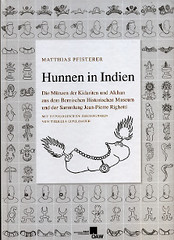
PREV ARTICLE
NEXT ARTICLE
FULL ISSUE
PREV FULL ISSUE
BOOK REVIEW: HUNNEN IN INDIENUrsula Kampmann published a review of a new book on an obscure numismatic topic,
Huns in India. It appeared in the October 9, 2014 issue of CoinsWeekly -Editor
On hearing the word “Huns”, even historians won’t be able to come up with much more than the name “Attila”. Only very few people are aware of the fact that further Hunnish kingdoms existed in the border area between Iran, Central Asia and India. The knowledge that coin collectors and numismatists have of the Kidarite kingdom or that of the Alchan is equally limited. This is evident when looking at the fact that similar coins which originated in these kingdoms are often described in auction and collection catalogues very differently, depending on the state of research reflected in the reference work that was available to the catalogues’ editors at the time of publication. So you keep hoping for a new work of reference that will once and for all end this catalogue madness. Now Matthias Pfisterer has paved the way. In revising the catalogues of the collection at the Historical Museum in Bern (Switzerland) and that of private collector Jean-Pierre Righetti, Pfisterer not only consulted these two collections, but many others: in Islamabad, New York, Toyko and many more places, as the book’s acknowledgment indicate. The greatly widened scope of available material provides a real treasure and enables new insights in this field of numismatic research, which currently enjoys great popularity. In 2010 for instance, Joe Cribb published his seminal paper on the Kidarites (Joe Cribb, The Kidarites, the Numismatic Evidence. With an Analytical Appendix by A. Oddy, in: Coins, Art and Chronology II – The first millennium C.E. in the Indo-Iranian borderlands. Wien 2010), so that the author of “Hunnen in Indien” (“Huns in India”) could afford to limit the respective chapter to a five-page summary. His study on Alchan coinage, on the other hand, comprises some 170 pages and, due to the much increased quantity of material today, far exceeds the scientific scope of Robert Göbl’s four-volume publication “Dokumente zur Geschichte der iranischen Hunnen in Baktrien und Indien” from 1967. Mind you, Matthias Pfisterer lays no claims to rewriting the history of the forgotten Alchan people. He successfully limits himself to describing the Alchan coin history, including a reconstruction of the structure and system of Alchan coinage, in as much detail as possible. The publication, written according to the Viennese system (“Wiener Aufbau”), is difficult to read but provides a valuable starting point for further research. For that reason, the text addresses only an extremely limited audience. Almost everyone consulting it prior to the publication of a catalogue will immediately jump to page 207, where the collection catalogue Bern/ Righetti begins. To read the complete article, see:
Wayne Homren, Editor The Numismatic Bibliomania Society is a non-profit organization promoting numismatic literature. See our web site at coinbooks.org. To submit items for publication in The E-Sylum, write to the Editor at this address: whomren@gmail.com To subscribe go to: https://my.binhost.com/lists/listinfo/esylum All Rights Reserved. NBS Home Page Contact the NBS webmaster 
|
